Military cargo taxi
A century ago, many military experts thought that during the war it was enough to requisition civilian transport for military needs. However, over time, it became obvious that you could not put a tank on a “staff” truck. In addition, civilian vehicles were too variegated and therefore not reliable for the military: we had to build dozens and hundreds of modifications of army trucks, but assembled in no more than half a dozen chassis.
The importance of vehicles for the supply and transportation of troops showed the experience of the First World War. Here is an example included in the anthology: already at the beginning of September 1914, German troops approached Paris; battles were fought on Marne in 50 kilometers from him. In Paris, the 7-Infantry Division was stationed, but there was not enough funds for its quick transfer to the front in full force. The commander of the Fortified Paris decided to use the city taxi. On the night of September 8, 1 100 “mobilized” Renault brought five battalions of one infantry brigade to the front (the other brigade with all the artillery arrived by rail), and in the morning the division entered the battle, attacking the flank of the German attack group. The local episode of the Marne battle became a legend, and the “Marne taxi” marked the beginning of a massive road transport of troops. The number of cars in the troops was growing rapidly. In the 1918, in the French army there were about 95 000 cars, in the British - 80 000, in the German - 60 000. The Russian army at the expense of purchases abroad by October 1917, received a little more than 21 000 cars.
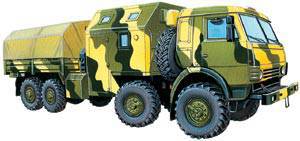 Artillery tractor on KamAZ-63501 “Mustang” (8 × 8) chassis, Russia. Cockpit and crew - with the reservation, there is a crane for loading ammunition. The mass of the towed system is up to 15 t, the engine is diesel, 360 l. with., speed - up to 95 km / h
Artillery tractor on KamAZ-63501 “Mustang” (8 × 8) chassis, Russia. Cockpit and crew - with the reservation, there is a crane for loading ammunition. The mass of the towed system is up to 15 t, the engine is diesel, 360 l. with., speed - up to 95 km / h After the First World War, it seemed to many enthusiasts that it was enough for the state to stimulate the development of civilian transport in order to provide them with an “automobile service” in case of war. More sober heads required the development of vehicles specifically for the army (taking into account particularities in the construction of civilian models), compulsory military training of civilian drivers, expansion of automobile units in the army, and the introduction of vehicles into the state of combat units. Funny, but indicative fact: in the case of the same “Marne taxi”, drivers, transporting troops, overtook each other out of habit, so that upon arrival at the place we had to spend time on putting the mixed units in order. Yet military motorists and their own army vehicles were preferable. So with such comfort as in a civilian taxi, the soldiers no longer drove.
Of course, no one has canceled the mobilization of civilian transport in case of war. But the Second World War clearly showed that, in conjunction with civilian technology, the fleet is too unsuited and poorly adapted to military service. Meanwhile, the need for supply and supply was too great. During the war years, the Red Army received about 205 000 cars from the domestic industry and 477 785 - from abroad. In the USSR at the beginning of the 1950-ies, the army was finally fully motorized, and work began on vehicles of various purposes and carrying capacities. Most of the machines supplied later to the national economy had army "twins" or prototypes. Many, say, remember the ambulance cars, minibuses, bread vans on the chassis of the UAZ-452. Rarely remember that this all-wheel drive car, nicknamed "Loaf", was originally created for military needs.
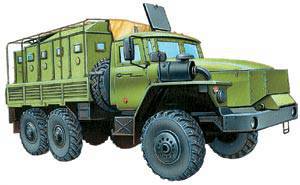 "Ural-4230-01" (6 × 6) with local booking and disguised armored module for personnel. Weight - 9,62 t, load capacity - 5 t, engine - diesel, 240 l. with., speed - up to 80 km / h
"Ural-4230-01" (6 × 6) with local booking and disguised armored module for personnel. Weight - 9,62 t, load capacity - 5 t, engine - diesel, 240 l. with., speed - up to 80 km / h The continuous increase in demand for the means of transportation can be judged by such figures. During the First World War, the daily consumption of all types of material resources per soldier was 6 kilograms, in the Second World War 20, in local wars 1970 — 1980-s — 90, in the Persian Gulf war in 1991 year — 110 kilograms (not counting water delivery). "Replacing a person with equipment" and some reduction in manpower in contingents of troops does not reduce the volume of supply, only the range of goods changes. In 1999, the weight of the ammunition required by the grouping of troops in Dagestan (quite, by the way, limited) was 1 300 tons. Only during the second Chechen campaign, from 1999 to 2002, did military motorists transport 457 775 tons of various cargoes.
No development of other types of transport cancels the enormous role of BAT in the transportation and supply of troops. Now for this purpose, multi-purpose or specialized wheeled trucks of normal, high and high traffic, tracked conveyors and conveyors, trailers, heavy trucks. We would call at least non-four-wheel drive vehicles KamAZ-5320, MAZ-500A, truck-mounted tractors with KamAZ-5410, widely used by Soviet troops in Afghanistan (and Russian in Chechnya) on hard-surface roads. On unpaved roads, the same tasks were solved by all-wheel drive KAMAZ-43105 and Ural-4320, tractors TC-6 on the chassis of the Ural-4320.
We can do everything
The main role in the BAT system of all armies is played by multi-purpose wheeled vehicles. In addition to transporting personnel and a variety of goods - from ammunition to food and batteries - and towing cargo trailers, they serve as a base for artillery tractors, tanker trucks, radar stations, control points. On the chassis of multi-purpose vehicles, trailers and semi-trailers mounted various weapons, equipment and special equipment of different types of troops. Only mobile means of repair on automobile chassis include technical assistance vehicles, technical maintenance workshops specialized in types and brands of serviced equipment, electrical charging stations, control and testing machines for guided weapons complexes — you can continue to list them. Already in the 1980-e years, the number of options for using the chassis of multi-purpose vehicles reached several hundred - among them countless modifications of the triaxial 3,5-ton ZIL-131.
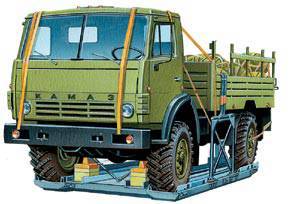 KamAZ-43501 "Mustang" (4 × 4) on the parachute landing platform П-7Н, Russia. Vehicle weight - 7,7 t, load capacity - 3 t, towed trailer weight - 7 t, engine - diesel, 240 l. s., speed - 90 km / h
KamAZ-43501 "Mustang" (4 × 4) on the parachute landing platform П-7Н, Russia. Vehicle weight - 7,7 t, load capacity - 3 t, towed trailer weight - 7 t, engine - diesel, 240 l. s., speed - 90 km / h Multipurpose cars in the structure of BAT are mainly represented by two-, three- and four-axle vehicles with a carrying capacity from 0,6 to 20 tons. These are, as a rule, all-terrain vehicles - all-wheel-drive, with wide-profile single-pitch tires and a centralized system for regulating pressure in them, high ground clearance.
In the last two decades of the 20th century, work began on a new generation of BAT. For multi-purpose vehicles were presented, in particular, the requirements of greater specific carrying capacity, greater maximum and average speeds, better maneuverability, increased power reserve. And at the same time, what is important is the greater unification of the base chassis. With all the difference in approaches and adopted programs, one can single out general trends in the development of BAT. One of them is the transition to diesel engines, associated with their high efficiency and the ability to reduce the range of fuels used in the troops. The use of gaseous fuels, adiabatic, turbo-compound engines, or, say, electrical transmissions from the agenda has not been removed, but they are not expected to yield immediate results from these areas. Efficiency of the course, as well as convenience and ease of management, contribute to the automatic transmission with electronic programmable control devices clutch and gearbox. Important and power steering - after all, BAT is driven mainly by people of average qualification and physical fitness. This generally coincides with the areas of civilian automotive industry - the military and civilian needs of motor vehicles are still closely related. True, there is a certain “inverse dependence” between them - the power density of military models, as a rule, is greater than that of civilian counterparts, while the nominal carrying capacity is somewhat less. A military vehicle needs a reserve of power for driving on difficult terrain. The army truck is devoid of the designer delights of commercial vehicles, but it is subject to more stringent requirements for durability, reliability, multi-fuel capacity, ability to withstand overloads and overcome fords, corrosion resistance of assemblies and parts, limiting the number of lubricants. It also requires the possibility of rare and simple maintenance, adaptability to rail and air transport.
In the USSR, and later in Russia at the end of 1980-x - the beginning of 1990-s, work was carried out on the creation of unified cars with 4 × 4, 6 × 6 and 8 × 8 wheel formulas and with a load capacity from 4 to 15 tons. Such works with the participation of the 21 th Research and Development Institute of the Ministry of Defense, for example, were held at the Kama Automobile Plant on the theme “Mustang”, at the Ural Automobile Plant - “Motovoz”. The KamAZ-4350 (4 × 4), -5350 (6 × 6) and -6350 (8 × 8) vehicles made up the basis of the Mustangs family, and “Ural” -43206 (4 × 4) machines -4320 (6 × 6) and -5323 (8 × 8). In parallel, work was underway on new trailers and semi-trailers - all the more so because part of their manufacturers remained in the sovereign states formed after the collapse of the USSR. The catastrophic state of the domestic economy has strongly delayed the emergence of a new generation of BAT in the army. In the meantime, the equipment used was getting older and it was becoming more and more difficult to repair it. Only in 2005, it was decided to adopt new families. As a result, at least 6 basic models of multi-purpose vehicles should be received by the army. True, the basic chassis themselves are now more unified - the internal unification of the Ural and KamAZ families by units and aggregates reaches 80 — 85%, and for all the chassis, KamAZ diesel engines have been chosen. Carried out the unification and “along the organizational line”, dividing the “areas of responsibility” between the families. That is, the Autotransporters of the Ural Automobile Plant must provide all transportation in the military unit, as well as the needs of the Navy support units and the anti-aircraft missile forces of the air defense, while the KamAZ Mustangs were left behind by the operational unit, the Air Force and the air defense, the formations and rear units, as well as troops. For the latter, on the basis of the four-ton KamAZ-4350, a three-ton KAMAZ-43501 was created, sometimes called the "Mustangen". I must say, the proposals to leave the unified base chassis within the battalion or regiment have been expressed for a long time - in the fleets of other regiments together served "Urals", Kamaz, KrAZy, ZiLy, Oise. The new system allows to reduce the number of brands of cars performing cargo transportation within the military unit from 8 to 3, and by increasing the load capacity to reduce the number of cars. The unification of the chassis also makes it possible to reduce the number and composition of the auto-equipment required by the troops, to unify the means of maintenance and repair and, importantly, to simplify the training of drivers. However, the previous models, apparently, will have to serve more than one year.
GAZ-3937 (4х4), Russia. Weight - 6,6 t, load capacity - 2,1 t, or 10 man with weapons, towed trailer weight - 2,5 t, engine - diesel, 175 l. s., travel speed - up to 112 km / h, power reserve - 1000 km
"Shishiga" with "Unimog"
Light all-wheel drive two-axle trucks with the wheel formula 4х4 in the army is a lot of work. The choice of a multi-purpose military vehicle is always a compromise between payload, travel speed, reliability, cost, and economy. An example of a successful compromise for its time is Shishiga, as the Soviet truck GAZ-66, with a carrying capacity of up to 2 tons, which was held in production for 35 years (produced until 1999 of the year), was called. He had a high power density - about 30 l. with. per ton, a wide range of traction and showed remarkable throughput and performance not only in the army, but also in agricultural work. He was replaced by GAZ-33081, but the military, as we have seen, preferred the more heavy-duty KamAZ-4350.
We can mention the German "Unimog", many years working in different countries of the world. Characteristic decoding "Unimog" - Universalmotorgera ..te, or "universal vehicle". The new generation Unimog 4 × 4, created by Mercedes-Benz, includes cars of three load-bearing levels (U3000 - 2 tons, U4000 - 3, U5000 - 5) with diesel engines in 150 — 218 l. with., and in each there are options with a shortened and elongated base. Interesting features such as a “twisting” frame, an electropneumatic transmission, pneumatic control of the transfer case and differentials, ground clearance in 440 — 480 millimeters, large wheels with low pressure tires, small body overhangs in front and behind. All this provides a very good throughput and handling.
The 4 × 4 chassis of the DURO car family by the Swiss company Bucher-Guer is originally made. The wheels of each pair are attached to a tubular subframe, hinged to the frame of the car and connected via a balancer to another subframe. As a result, moving or tilting one wheel causes the others to move in such a way that the car on the slopes and unevenness keeps the wheels in contact with the ground, but does not experience a significant roll. A ground clearance without protruding crankcase contributes to the terrain. This suspension was applied to the model 6 × 6. You can see here the development of the idea of a "turning point" in the longitudinal plane of the frame, embodied by the company "Berlie" as far back as 1920-s.
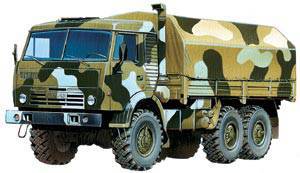 KAMAZ-5350 Mustang (6 × 6). Weight - 8,54 t, load capacity - 6 t, towed trailer weight - 12 t, engine - diesel, 260 l. with., speed - 100 km / h, the range of fuel - 1090 km
KAMAZ-5350 Mustang (6 × 6). Weight - 8,54 t, load capacity - 6 t, towed trailer weight - 12 t, engine - diesel, 260 l. with., speed - 100 km / h, the range of fuel - 1090 km Either in uniform or in civilian clothes
The use of BAT directly in military units in combat conditions, it would seem, requires building it on the basis of the same components and assemblies as army armored vehicles. This experience is available - GAZ-3937 (with a tandem cab, unarmoured) and GAZ-39371 (with a conventional cabin layout, armored) of the Vodnik series, developed in Nizhny Novgorod and manufactured by the Arzamas Engineering Plant, are based on the BTR-80 units . And 26 replaceable modules (transport, cargo, combat) allow you to perform on this chassis with a mechanical transmission and an independent torsion bar suspension of the machine for various purposes.
The close connection of transport and transport machines is also evident in the Dingo-2 family, developed by the German company Krauss-Maffei-Wegman based on the same Unimog, although here commercial aggregates are used to a greater extent. The characteristic features of the car are independent wheel suspension and a large hood - after all, I had to place the engine in 230 l. with., - as well as a high cab, providing the driver a good overview. For the same serves as a rearview video system.
On the other hand, an unexpected example of the use of the most "peaceful" chassis was developed by the Mungo transport armored vehicle, made on the basis of ... the Multicar truck for urban utilities. The fact is that the Bundeswehr paratroopers involved in peacekeeping and counterterrorism operations abroad needed a machine that could transport a ten-person compartment, carry anti-bullet booking and, at the same time, fit into military aircraft and a CH-53 helicopter. So they chose a smaller chassis.
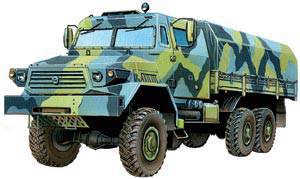 "Ural-6320" 6 × 6 (Russia) with a cab of frame-panel type, local booking, diesel engine in 400 l. with. and full weight up to 33,5 t
"Ural-6320" 6 × 6 (Russia) with a cab of frame-panel type, local booking, diesel engine in 400 l. with. and full weight up to 33,5 t "One two"
The most common in the armies of multi-purpose vehicles with carrying capacity from 5 to 10 tons. Basically, these are three-axle all-wheel drive vehicles with axes distributed according to the “1 — 2” scheme, that is, with the rear axles being pulled together. The “1 — 2” scheme is well suited for highways and provides a favorable distribution of loads along the axes, although in overcoming horizontal obstacles it is inferior to the “1 — 1 — 1” scheme - a uniform distribution of axes along the length of the machine. The last, which is interesting, can be found on a number of floating trucks like the British “Stolvet” or the Soviet floating chassis BAZ-5937, and close front axles (“2 — 1”) in tractors with two controlled axles like the Czech “Tatry-813” . Multi-axles may also differ in the location of the engine and cab, the scheme and type of transmission, wheel suspension.
The machines of the “1 — 2” scheme include, for example, the Russian “Ural-4320”, which showed itself well in the course of hostilities in the North Caucasus. Among its advantages was the classic layout with the location of the engine ahead of the cab - when hitting a mine in such trucks, the driver is more likely to survive. It is curious that the same layout was chosen for the American "tactical" 6 × 6 trucks of the Oshkosh family. Moreover, the three-axis Oshkosh family included four main modifications at once, differing in the length of the wheelbase and loading platform, carrying capacity, presence or absence of a winch - the desire to “close” a wide range of possible customer requirements on the basis of, in fact, one machine. "Ural4320", by the way, also has modifications with an extended base.
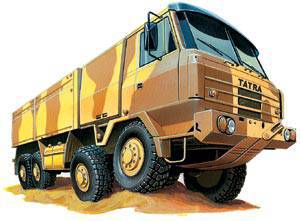 Tatra T816 (8 × 8) of the Force series, Czech Republic. Diesel engine may have power 544 or 830 l. with.
Tatra T816 (8 × 8) of the Force series, Czech Republic. Diesel engine may have power 544 or 830 l. with. Octopuses
An increase in the number of axles is required to increase the load capacity (and preserve the cross-country ability). Therefore, the appearance in addition to the three-axle and four-axle chassis with the wheel formula 8 × 8 was inevitable. Despite the greater complexity, they are preferable to a three-axle for a load capacity of 10 — 15 tons and above. However, it is possible to increase the number of axles and further - depending on the need. The development of the 8 × 8 chassis took a long time to unfold - in Germany, for example, Daimler-Benz and Magirus presented them in 1927 — 1928; in the USSR, the four-axle YG-1932 truck and the experienced chassis of Brigiengen E. Y. Chudakov. By the way, in the same 12, the German Bussing introduced the 1932 × 10 chassis.
Of the various 8 × 8 chassis schemes, the most common are “2 — 2” with close extreme axes and “1 — 1 — 1 — 1” with their uniform distribution. Managed can be two front axles, front and rear, or all at the same time. The “2 — 2” scheme provides the greatest stability of movement, maintaining contact with the ground when overcoming long irregularities, although the width of the ditch to be overcome is inferior to “1 — 1 — 1 — 1” or “1 — 2 — 1”.
The 8 × 8 chassis also perform well as a conveyor tractor. For example, an artillery tractor was mounted on the KAMAZ-6350 chassis, which, besides calculating in an armored cockpit and ammunition in the back, can carry fire control equipment. The BAZ-6593 8 × 8 of the Bryansk Automobile Plant is designed for towing 152-mm 2A36 “Hyacinth-B” artillery system or air defense systems weighing up to 15 tons. These cars occupy a kind of niche between multipurpose trucks and heavy tractors.
Vans and containers
It would be simple if all shipments were to load cars at one point of departure and unload at the final destination. In fact, cargo has to be transferred several times, especially when using troops abroad (for example, in UN operations), when the range of delivery of material and technical means increases many times over. Anyone who has had to manually load, unload and overload even unimportant loads that fill the body of the 5 — the 6-ton truck knows how much time and effort it takes. And if the same personnel need to immediately also put this load into action? The solution to the problem in military transport is the same as in commercial transport — the use of cargo containers that meet international standards and are adapted for transportation by air, sea, rail and road. This facilitates the use at certain stages of delivery of commercial vehicles and loading and unloading facilities. However, it is required to equip the automobile chassis with loading and unloading systems like "Multilift". Examples are the American FMTV-LHS system on the FMTV car chassis, the French PLM17 on the RM19 chassis, and the Finnish Sisso HMLT.
A great achievement half a century ago was the emergence of universal body-vans of the KUNG type, mounted on various car chassis or trailers and designed for mounting various equipment and relatively comfortable accommodation of people serving this equipment. But over time, for these purposes, it turned out to be more convenient container bodies, which, if necessary, can either be left on the chassis or unloaded onto the ground. Work on them in different countries, including the USSR, began in the 1980s and 1990s. Modular containers have been created to accommodate military personnel, equipment of command and control posts, medical posts, armory rooms, electrical installations, bakeries and so on. And kitchens, bakeries, field canteens and other food service vehicles play, by the way, an important role in supporting the combat readiness of troops. Increasingly widespread are container bodies of variable volume, which unfold in place like a matchbox.
Pinzgauer (6 × 6), Austria. Weight - 2,5 t, engine - diesel, 136 l. with., speed - up to 112 km / h, power reserve - 700 km. An example of a light three-wheeler-SUV
Life in the rear
Currently, the concept of "rear zone" does not mean safety. The tasks of transportation, supplies and technical support for the troops have to be carried out with the constant danger of shelling, especially in the areas of counterterrorist operations. This requires solving problems of increasing the security and survivability of multipurpose machines and their modifications. The solution has to be found in several directions. One of them is a reduction in visibility in the optical, infrared, radar, and also seismic-acoustic ranges. These include the use of means of blackout, deforming camouflage paint, thermal insulation of the power plant, screen-ejector devices for exhaust systems, radio-absorbing coatings and removable covers, covering wheel alloys with false boards.
The next direction is the reduction of vulnerability from the damaging factors of various weapons. In our country, this problem has been dealt with since the Afghan war. “The column goes past mountain peaks, meadows and fields in multi-colored patches and past the skeletons of burnt cars that were also columns once” - this is how the poet Mikhail Kalinkin described the movement of transport columns in the mountains of Afghanistan. The main danger was shelling from automatic weapons and mines. And already in the 1982 — 1985 years they carried out work on a mounted local reservation for Ural and KamAZ vehicles. It is mainly about the armor protection of the cabin, the most important units and mechanisms. The development of the first Chechen campaign required further development. The main means of protection is steel armor. Armor plates can be bolted directly to the surface of machines or to a special frame. At the same time, the carrying capacity of cars with the same cross-country ability should not decrease by more than 15%.
NATO countries are very concerned about the protection of transport vehicles during the aggression against Yugoslavia. And by March, 2005 had 25 300 armored vehicles, including various Humvees and jeeps, by the US military in Iraq.
Back in 1990-ies, the danger of delivering even humanitarian aid in areas of interethnic conflict created a UN requirement to book used trucks. Note that the Russian options for local booking of heavy trucks with steel armor 4 — 8 millimeters thick, many foreign experts recognized as optimal. True, this did not prevent, for example, the Hungarians in 1999 to detain Russian humanitarian supplies for Yugoslavia at the border by declaring civilian trucks protected by armor as “military vehicles”, which, however, can be explained simply by the excessive enthusiasm of the new NATO member.
The already mentioned “Ural-4320”, in a protected version, in addition to booking an engine and a cabin, received a filter-ventilation installation, radiation and chemical reconnaissance devices, a machine gun installation, and night-vision devices allowing it to do without headlights. An armored module disguised by a conventional awning can be mounted in its body for soldiers with embrasures for firing from an individual weapon.
Cars for fuel supply are also booked, for example, British and German 18 and 15 vehicles with tankers with a capacity of thousands of liters on the 8 × 8 chassis with anti-bullet and splinter armor cabs and cisterns. The camouflage of the tanker works as an ordinary truck. For example, a fuel tank with a pump can be covered under the tent of the “Ural” or KamAZ. Characterized by work on booking evacuation vehicles and technical assistance vehicles.
In a number of programs for developing new multi-purpose machines, the possibility of booking is provided for initially. More and more widely used in them are fire resistant wheels with rigid inserts that allow you to move on a punctured and flat tire. The insertion of the German company “German Prokyurement” also plays a “mine action” role, taking part of the explosion energy to its destruction (there is no need for movement) and directing part of the explosive gases away from the car.
Accompanied by armed vehicles - also a means to increase the security of the columns. And here again is the work of multi-purpose machines. Both in Afghanistan and in Chechnya, ZU-23 anti-aircraft guns were used, installed in the back of a KamAZ or Ural vehicle and disguised until being used by an awning.
Tractor KZKT-74281 Rusich (8 × 8) with a tank T-90C on the KZKT-9101 semi-trailer, Russia. The mass of the tractor is 25 tons, the number of seats in the cab is 6, the carrying capacity of the semi-trailer is 52 tons, the engine is diesel, 650 liters. sec., speed - up to 70 km / h, cruising range - 705 km
Tanks by taxi
The armies were not only motorized, but also mechanized, that is, equipped with combat vehicles. Now it is difficult to imagine even local fighting without the participation of tanks and self-propelled guns. But heavy tracked vehicles, as is well known, are significantly inferior to wheeled vehicles in speed and economy of movement on roads and in running gear; moreover, they damage the hard surface of the roads. Therefore, they are trying to make their transfer over long distances not on their own, but on special conveyors. Wheeled transporters of tanks exist almost as much as the tanks themselves: the French, for example, already in 1918, used two-axle car trailers to transport their tanks.
Modern light class armored vehicles can be transported on a cargo platform of conveyors like the four-axle 6350 KamAZ (8 × 8) with a loading and unloading system such as Multi-lift or the five-axle Ural-6923 (10 × 8 or 10 × 10). The Ural-632361 10 × 10 transporter can carry loads of up to 24 tons - the BMP-3 weighs so much.
The carrier of the main battle tanks is a road train consisting of a multi-axle semi-tractor and a heavy-duty platform trailer. Folding entry ladders and a hoist with a hoist allow you to load the car on the trailer, the crew of the transported car can be accommodated in the tractor cab. Tank transporters also serve to evacuate damaged heavy equipment to repair bases, and themselves become the base for special vehicles.
The well-known Soviet tractor MAZ-537 (8 × 8), which served as a tank transporter and towing trailers with ballistic missiles. To replace it, a road train for the Kurgan wheel tractor plant was developed as part of the KZTK-74281 tractor (8 × 8) and the two-axle KZKT-9101 semi-trailer with a payload of up to 53,5 tons. On the basis of the KZKT-74281 tractor, the MTP-A4 technical assistance vehicle was made, and its modification, KZTK-74282, serves as an airfield tractor for aircraft weighing up to 200 tons.
The American Abrams tanker truck includes a M1070 8 × 8 meter tractor with a diesel engine in 500 l. with. and a five-axle semi-trailer М1000 with an adjustable loading height of the platform (due to the hydraulic system of the suspension) and semi-trailer carts controlled from the driver’s seat. A five-axle trailer GTS1000 allows you to transport a tank weighing up to 72 tons or two armored vehicles weighing 36 tons - the necessary response to the growing combat weight of armored vehicles.
- Semen Fedoseev
- http://www.vokrugsveta.ru"rel =" nofollow ">http://www.vokrugsveta.ru

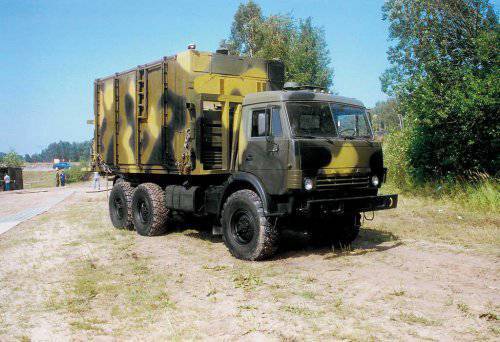
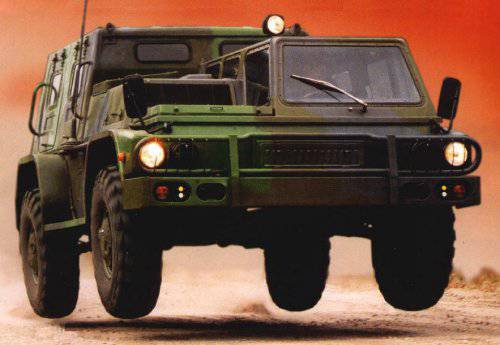
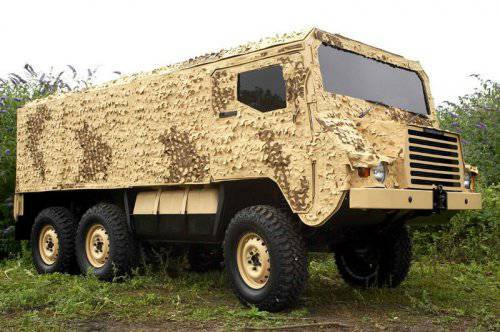
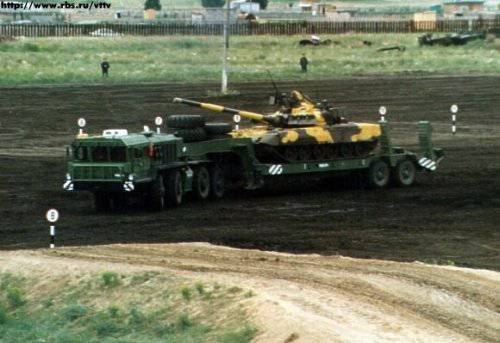
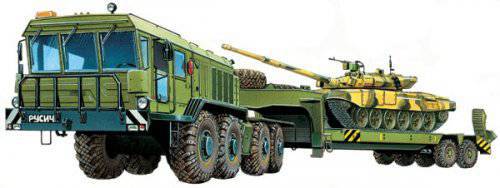
Information